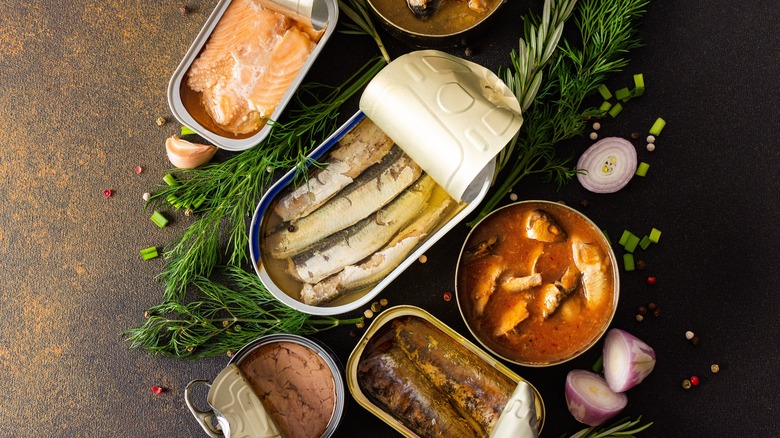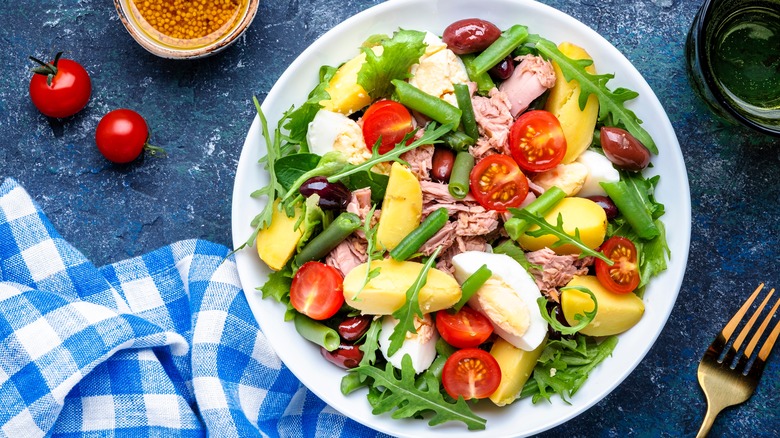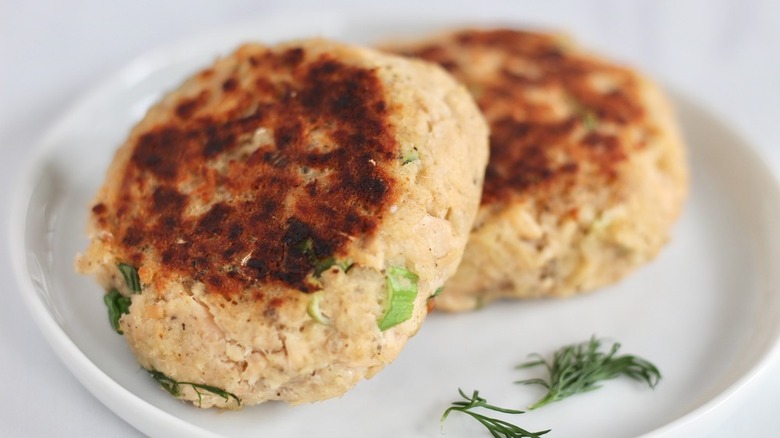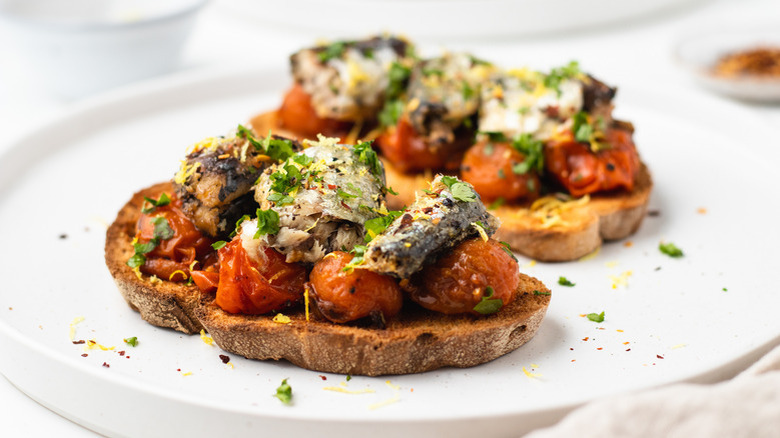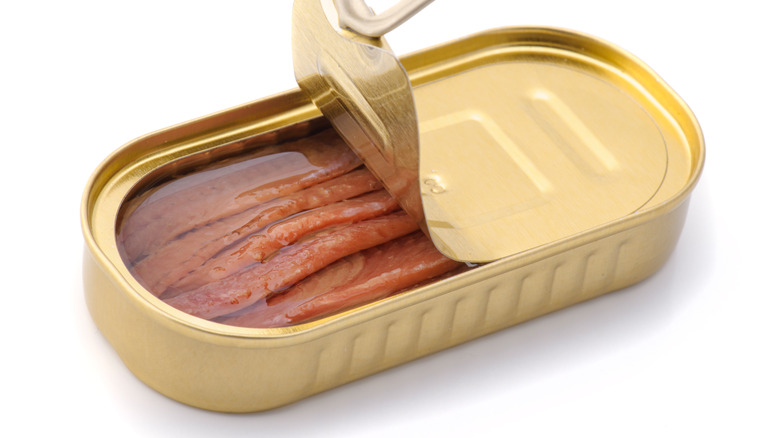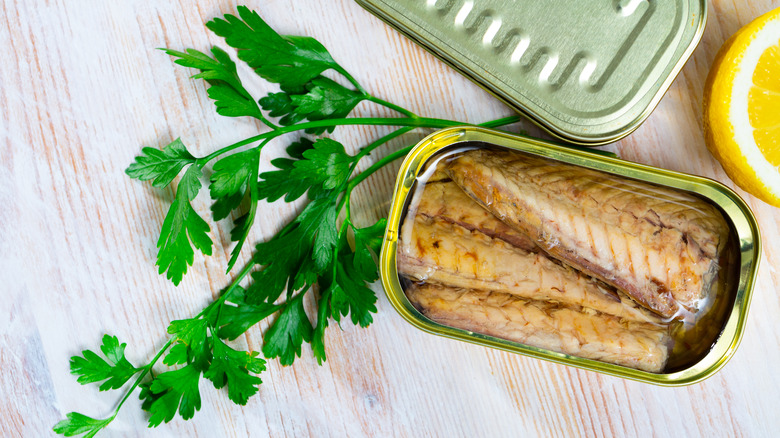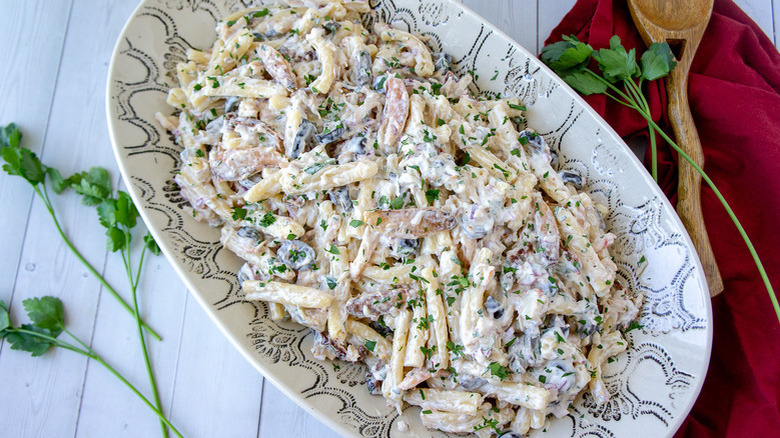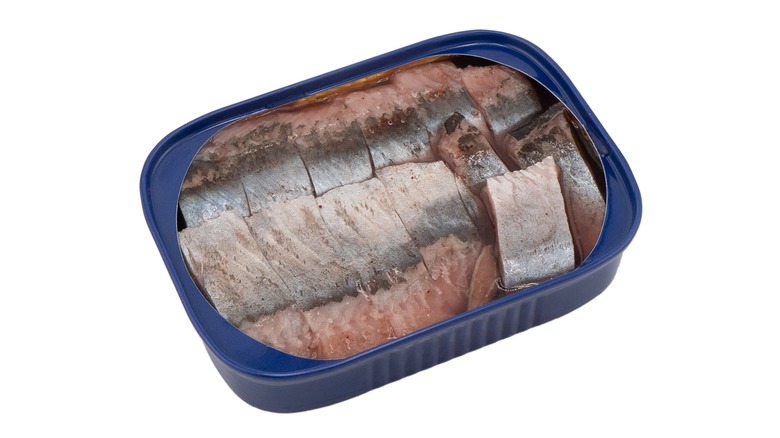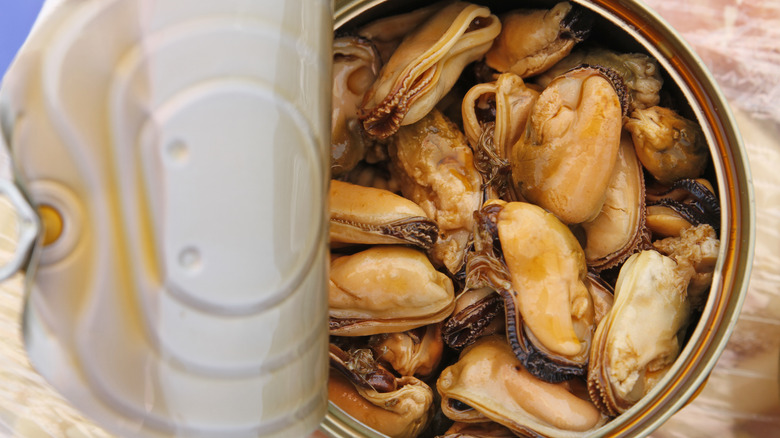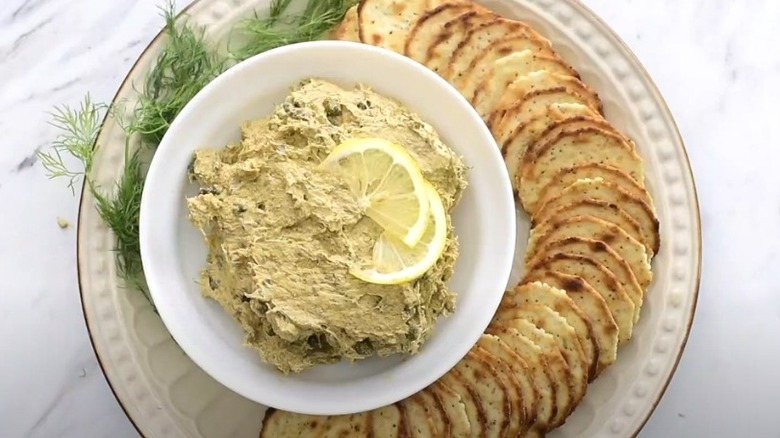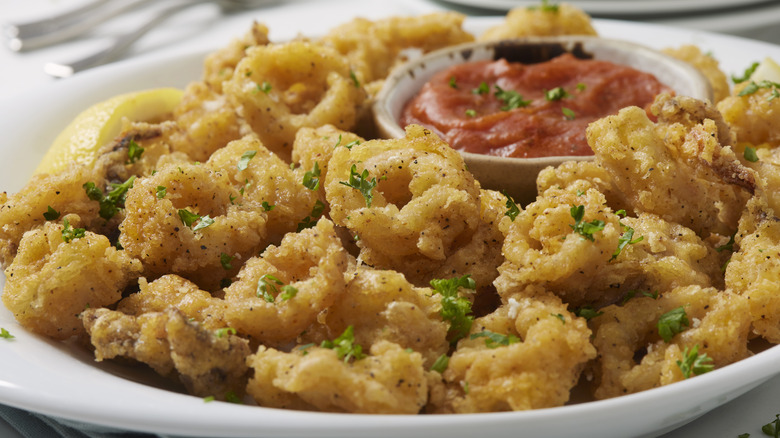Everything You Wanted To Know About Canned Seafood, According To Chefs
When prepping a seafood dinner, a fillet of fresh fish is often the what we favor as the star of the meal. Fresh fish is undoubtedly delicious and nutritious, but it often overshadows another form of seafood — canned fish. But in reality, selecting canned fish can actually bring a whole host of amazing benefits, from its ease of storage and prep, to its soft, edible bones and rich nutrients.
Using this conveniently packaged form of fish can add heaps of flavor and a healthy dose of protein to your dishes with far less effort than what is required to prepare its fresh counterpart. That's largely because canned fish is readily available, incredibly budget-friendly, and comes in many varieties. Whether you're making a quick and easy lunch at home or preparing a more sophisticated meal for guests, there's a type of canned fish to suit your needs.
Most of us have probably grabbed a can of tuna or salmon at the store, but did you know that other types of seafood like squid and trout can come in this conveniently preserved form too? We asked experts for their input on the world of canned fish so we can explore its diversity, versatility, and the many ways to incorporate it into your home cooking. If you're a fresh fish devotee, we hope we can provide you with some newfound inspiration to give one of the many canned varieties a go in your next recipe!
Tuna
Tuna is perhaps the most well-known and widely consumed type of canned fish. It has a mild flavor, firm texture, and typically comes packed in either oil or water. Canned tuna is incredibly versatile too, making it an amazing pantry staple to have on hand for transforming a wide variety of dishes.
A classic way to use canned tuna is in Niçoise salad, where it's combined with boiled potatoes, hard-boiled eggs, olives, and fresh, vibrant veggies. Then, everything is drizzled with a deliciously lemony dressing. This one is perfect to enjoy on a warm summer day.
Jared Garner, Chief Scallop Officer at FishNook Tinned Seafood Co., provided us with some insight on alternative cuts of tuna that are also available in canned form. "I love the 'meaty' seafoodiness of tuna, and even more so when it's a richer cut like the belly," he says. "That extra fat offers a more flavorful experience than your typical can of tuna."
Garner enjoys incorporating canned tuna belly into a fresh sushi handroll. His recipe of choice involves adding cooked sushi rice, tuna belly, sliced cucumbers, carrots, and avocado to a sheet of nori. "To balance the fattiness of the tuna belly, squeeze some lemon over everything or dress with a nice vinegar. Finish with a small squeeze of Kewpie mayo and Sriracha too if you'd like a bit of spice. Roll all of the ingredients into a cone-shaped hand roll, bite, and enjoy," says Garner.
Salmon
Versatile, nutrient-rich canned salmon is another brilliant option to have in the pantry. This fish is an excellent source of protein, omega-3 fatty acids, and essential vitamins like D and B12. It typically comes in red or pink varieties, has a rich flavor, and can fit just as well into an everyday meal as it can into a sophisticated dinner party dish.
Since it's already cooked, you can eat canned salmon straight out of the tin if you so desire. However, we recommend trying one of the many delicious recipes you can whip up using this convenient form of fish. FishNook's Jared Garner regularly opts for canned smoked salmon as a convenient bagel topping. Here's his go-to method: "Prepare your favorite bagel with a schmear of cream cheese or creme fraiche. Sprinkle on [a] combination of capers, thinly sliced red onion, and dill. Finally, crack open your tin of smoked salmon and flake it over the bagel you've prepared. Finish it all with a squeeze of lemon and a sprinkle of sea salt."
Salmon patties are also a flavorful and budget-friendly recipe that uses canned salmon and is great for meal prepping. To make the patties, just combine the drained canned salmon with green onions, dill, panko breadcrumbs, mayo, lemon, mustard, egg, and black pepper. Shape the mixture into patties and cook in a frying pan until golden and crisp.
Sardines
This small, oily fish is one that packs a punch both in terms of taste and nutrition. Canned sardines are a flavorful choice, with a meaty texture and an array of delicious applications in the kitchen. These fish are rich in calcium, which is essential for the health of our bones and teeth, as well as heart-healthy omega-3 fatty acids, which have been shown to have anti-inflammatory effects in the body.
According to Jared Garner, canned sardines can be "savored with minimal accompaniment". He often serves the fish as-is or with just a sprinkle of salt and squeeze of lemon juice. He offers a simple way to elevate this versatile canned fish, too, noting that you can "Lightly toast some sourdough and smear with good, French butter. Top the toast with a few sardines and then drizzle on your favorite hot sauce or grainy mustard or prepare a spicy aioli to your liking. Finish some fresh herbs like parsley, dill, or basil and you've got the perfect sardine setup."
Canned sardines often come packed in a ready-made sauce such as tomato, mustard, or chili mixtures. These are great options if you want to create a super quick yet flavor-packed dish, such as a sardine pasta or salad. If you're a seafood pizza fan, these fish make a brilliant topping too, particularly when they're served alongside olives, red onions, capers, or tomatoes.
Anchovies
Using anchovies in your cooking is an incredible way to amp up the umami flavors in a dish. Though they're smaller than sardines, canned anchovies are known for their intense, salty taste. Just a little of this punchy fish goes a long way to transform your recipe.
Albert Nguyen is a chef at the Institute of Culinary Education and he is a huge fan of using canned seafood in his dishes. When it comes to anchovies, his go-to recipe is a simple paste, "Place a whole tin of [anchovies] in a food processor with four times the amount of garlic," he says. "Process it until it becomes a paste, you can add some olive oil to help it get going." Nguyen keeps the anchovy-garlic paste in his fridge, using it as a flavorful base for other dishes. For an easy pasta dish, he says "I use it as-is, sautéed in a pan with a good helping of olive oil and some chili flakes. Cook it until the garlic is slightly golden and then toss in al dente pasta."
Anchovies can also be used to enhance the savory flavors of red meats as part of a marinade, made by sautéing the minced fish with garlic, shallot, rosemary, lemon, and chili. This is then rubbed on the meat, such as a leg of lamb or pork joint, before it cooks in the oven.
Mackerel
Canned mackerel is another convenient and hearty option, that fits into the oily fish category and can serve as a great alternative to tuna or salmon. Mackerel has a flaky texture and milder taste than sardines or anchovies, while still packing in plenty of goodness.
One unique way to use canned mackerel is to add it into your morning omelette, perhaps alongside ingredients like mushrooms, tomatoes, red onion, and a generous helping of shredded cheese. It's a fantastic way to add protein to your breakfast and since you can flake it in straight from the can, it' s super quick, too.
Chef Albert Nguyen's canned mackerel recipe of choice is a simple Japanese-inspired dish. "The base of the sauce is equal parts mirin, sugar, soy sauce, and sake all brought up to a boil, then simmered for about 3-5 minutes," he explains. "If you want to bring the flavor up a bit you can introduce some dashi or powdered dashi to this sauce. Once the sauce is ready, pour it over the mackerel and broil for about 5 minutes." He then serves this delicious mixture over steamed rice with a fresh side salad, describing the result as "a quick meal that will remind you of barbecue unagi (eel) over rice you might know from Japanese restaurants."
Crab
Prized for its sweet, delicate flavor and tender texture, crab is an incredibly popular form of seafood. Buying a good-quality variety in handy canned form is practically always a great idea. Using crab in your recipes is a wonderful way to add a subtle taste of the sea, with minimal effort required.
Pasta salads are a wonderful option for meal prepping or summer barbecues, and they're even better with the addition of canned crab. Try creating a creamy crab pasta dish with mayo, tomatoes, red onion, herbs, spices, and that all-important crab meat. Everything should come together in just 15 minutes before its ready to chill in the fridge.
Crab cakes are another easy and crowd-pleasing dish made by mixing the crab meat with mayo, Worcestershire sauce, mustard, egg, parsley, Old Bay seasoning, and breadcrumbs. Once you've formed that mixture into patties, simply fry them in a little oil until golden brown and serve with your favorite dip.
Herring
Herring is an oily fish with a rich, full-bodied taste, that can be used in much the same way as sardines or mackerel. When it comes to canned herring, you'll find that it often comes in smoked form. The smoking process adds an extra element of flavor and a deeper color while helping to preserve the fish.
There are plenty of ways to enjoy this flavorful fish, from tossing it into a salad or pasta dish, to blending it up into a smooth and creamy herring pate. A delicious idea would be to add flaked canned herring to a hearty potato hash. First, saute some onion, garlic, and bell pepper in a skillet. Then add par-boiled cubed potatoes and a sprinkling of paprika. Once everything is cooked through, mix through the herring and your nutritious brunch is ready to serve.
For a unique twist on your standard taco recipe, try incorporating some canned herring. Just heat up the drained canned fish in a frying pan along with some taco spices, and use the mixture to fill some soft tortillas. Other taco toppings that would pair amazingly with herring include shredded lettuce, cheese, guacamole, salsa, and sour cream.
Mussels
Love them or hate them, you can't deny that mussels are a staple in a wide range of seafood dishes, from paella to pastas and soups. But as they often come with the shell intact, they can be fiddly to prep and cook. That's where canned mussels come in, providing a more convenient way to enjoy this versatile mollusk without compromising on flavor.
Canned mussels have a tender texture and briny taste that fits perfectly into a range of dishes. To make a convenient version of a classic paella, add mussels alongside other types of canned seafood like tuna or squid. They'll compliment the fragrant saffron-infused rice, olives, and vegetables just as wonderfully as their fresh counterparts would.
Mussels and garlic are a classic pairing and chef Albert Nguyen tells us how easy it is to enhance the flavor of mussels with this simple aromatic ingredient. "One of my favorite and easy ways to make canned mussels feel special is to heat up a small pan of olive oil and add sliced garlic while its cold and let it sauté until just golden. Turn off the heat and sprinkle in some salt and smoked paprika. Lastly, add a dash of sherry vinegar and add in the mussels," he says. This sounds like as incredible way to allow the mussels to shine while introducing subtle complementary flavors. Nguyen assures us that this dish will "feel and taste like a fancy tapas".
Oysters
The idea of eating oysters typically conjures up images of slurping them straight from the shell in a fancy restaurant, not spooning them out of a can. But opting for canned oysters is an amazing way to make the most of the shellfish's silky texture and luxury taste in a much more convenient form. And there are so many different uses for them too.
We spoke to Jessica Randhawa, Owner and Head Chef at The Forked Spoon, who ran us through one of her much-loved canned oyster recipes. "They are wonderful in a traditional oyster stew or added to a seafood chowder," she said. "For the stew, simmer the oysters gently in milk or cream with butter, celery, and seasonings until just heated through to keep them tender and flavorful." Sounds like the ultimate comforting dish for the winter season.
Another delicious dish you can create with canned oysters is a simple but effective smoked oyster dip. This rich and creamy appetizer is perfect for scooping onto crackers. Make it by blending smoked canned oysters with cream cheese, mayonnaise, lemon juice, garlic salt, Tabasco sauce, and capers, all of which pair well with the briny flavor of the oysters. Or try deep-frying canned oysters by first dipping them in egg, flour, and breadcrumbs, then cooking in hot oil. This gives them an incredible crispy coating and creates a delicious bite-sized appetizer.
Lobster
Now considered to be perhaps the most decadent sort of seafood available on the market, lobster is renowned for its meaty texture and subtle, slightly sweet taste. Enjoying lobster doesn't have to mean buying it whole and struggling with that tough shell. Surprisingly, lobster meat is also available in a can.
While it's not quite as easy to find as some other types of canned fish, you can buy canned lobster online. And there's no reason to turn your nose up at the idea of eating lobster from a tin, as high-quality versions can taste just like the fresh lobster served in a restaurant.
So, how can you use canned lobster? Essentially, it should fit seamlessly into any dish that requires fresh lobster meat. Whip up some creamy lobster rolls by combining the drained canned lobster with mayo, herbs, spices, lemon, and hot sauce, then loaded up some toasted brioche buns with the meaty mixture. Or try making an elegant lobster bisque by adding the lobster meat to a rich broth infused with wine, tarragon, and cream.
Trout
Less commonly found in grocery stores, but applicable to similar recipes as canned tuna and salmon, canned trout is mild and tender, and often comes in flavorful smoked form. This fish is typically packed in rich olive oil, sometimes with the addition of lemon and herbs. The best place to get this canned fish is from a speciality online retailer.
According to Jessica Randhawa, "canned trout is particularly good in fish cakes or as a salad topping", which she says is due to its firm texture and rich flavor. Her favorite way to make use of this fish is to "mix it with a bit of mayonnaise, diced celery, and onion for a delightful trout salad that can be served on lettuce leaves or as a filling for a hearty sandwich."
For a delicious savory bake, try incorporating canned trout into a quiche. First, prep your pastry, press it into a fluted tart tin, and bake until golden. Then, mix the trout with onion, garlic, and your veggies of choice and spoon everything into the pastry case. Finally, pour a mix of eggs and cream on top, then bake until set. This fish also makes a wonderful addition to a charcuterie board, along with crudites, olives, crackers, and your favorite dips.
Squid
Squid is another type of seafood that's most commonly purchased fresh or frozen, but canned squid is can be an amazing ingredient to have on hand for throwing into seafood dishes. Squid has a firm texture and milder fishy flavor than mussels or oily fish. It's readily available in many grocery stores, where it's often labelled as calamari (simply Italian for squid).
Jessica Randhawa tells us that canned squid can be "excellent in pasta dishes or tossed with garlic, olive oil, and chili flakes for a quick seafood sauté." This is another ingredient that can shine as the star of a meal with minimal ingredient additions. Randhawa explains that her choice of aromatics and seasonings "highlights the squid's mild flavor but also infuses the dish with a Mediterranean flair that is simple yet sophisticated."
Canned squid is a fantastic ingredient to add to paella or risotto dishes, too. Try combining it with mussels or crab for a delicious seafood medley. Or, for a mouth-watering appetizer, make deep fried squid. First, place the canned squid into a bowl of milk and let it sit for half an hour in the fridge. Then, drain and dry the squid before tossing it in a mixture of flour and baking powder. Deep fry the coated squid in oil until golden brown and crispy. Don't forget to serve it with creamy garlic aioli!
